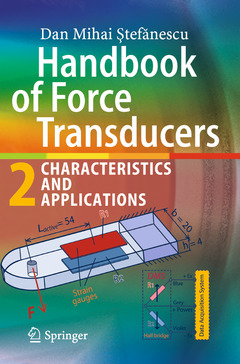Description
Handbook of Force Transducers (2nd Ed., 2nd ed. 2020)
Characteristics and Applications
Author: Ştefănescu Dan Mihai
Language: English
Subjects for Handbook of Force Transducers:
Approximative price 210.99 €
In Print (Delivery period: 15 days).
Add to cartPublication date: 01-2021
246 p. · 15.5x23.5 cm · Paperback
Approximative price 210.99 €
In Print (Delivery period: 15 days).
Add to cartPublication date: 01-2020
246 p. · 15.5x23.5 cm · Hardback
Description
/li>Contents
/li>Biography
/li>Comment
/li>
Part I introduces the basic ?Principles and Methods of Force Measurement? according to a classification into a dozen of force transducerstypes: resistive, inductive, capacitive, piezoelectric, electromagnetic, electrodynamic, magnetoelastic, galvanomagnetic (Hall-effect), vibrating wires, (micro)resonators, acoustic and gyroscopic. Two special chapters refer to force balance techniques and to combined methods in force measurement.
Part II discusses the ?(Strain Gauge) Force Transducers Components?, evolving from the classical force transducer to the digital / intelligent one, with the incorporation of three subsystems (sensors, electromechanics and informatics). The elastic element (EE) is the ?heart? of the force transducer and basically determines its performance. A 12-type elastic element classification is proposed (stretched / compressed column or tube, bending beam, bending and/or torsion shaft, middle bent bar with fixed ends, shear beam, bending ring, yoke or frame, diaphragm, axial-stressed torus, axisymmetrical and voluminous EE), with emphasis on the optimum place of the strain gauges. The main properties of the associated Wheatstone bridge, best suited for the parametrical transducers, are examined, together with the appropriate electronic circuits for SGFTs. The handbook fills a gap in the field of Force Measurement, both experts and newcomers, no matter of their particular interest, finding a lot of useful and valuable subjects in the area of Force Transducers; in fact, it is the first specialized monograph in this inter- and multidisciplinary field.The International System of Units (SI) and the Place of “Force” in European, Asian and American Graphic Representations. The New SI (2019).- Metrological Characteristics in the Measurement Process, with Examples in Weighing Cells.- General Classification of the Electrical Methods and Principles for Measuring Mechanical Quantities.- Application of Electromagnetic and Optical Methods in Small Force Sensing.- Strain Gauges – Resistive and Other Principles.- Wheatstone Bridges – Basic and Similar Configurations.- Evolution of Strain Gauge Force Transducers – Design, Fabrication, Testing, Calibration and Databases.- Testing Equipment to Investigate Elastic Constants of Rocks and Composites.- Static and Dynamic Stiffness in Connection with Ball Screws and Reinforced Concrete Components.- Methods and Means for Measuring Cables Tension.- Measurement of the Axial Loads Transmitted to the Foundation by High Voltage Circuit Breakers when Acting.- A New Weigh-in-Motion and Traffic Monitoring System.- Robotic and Biomedical Applications Related to Human Hands.- Multifunctional Transducers for Force and Other Non-Electrical Quantities.- Multicomponent Force and Moment Transducers.- Equipment for Determining Aerodynamic Forces on Flapping Wings.- Strain Gauge Balances for Testing Car and Flight Models in Wind-Tunnel Applications.- Recent Evolution of Smart Force Transducers.- New Achievements in the Field of Intelligent Force Transducers. Traceability.- Virtual Instrumentation and Force Transducer for Measurements in Dentistry.- A Supplement on Photoelastic and Digital Techniques in Force Measurements.
Complementary handbook for engineers, technicians, students and practitioners, providing a good deal of up-to-date information
Complete book in handbook style
Second volume of the successful “Handbook of Force Transducers” concentrating on Characteristics and Applications
Useful for experts and newcomers
Includes multidisciplinary applications, exhaustively presented and, finally, an example of virtual instrumentation in this field
Includes more than 190 colorful and informative illustrations and 260 bibliographical references bringing additional value and strength to this unique work about various applications with strain gauge force transducers (SGFTs) and their characteristics




